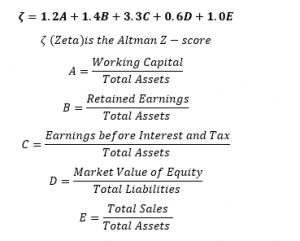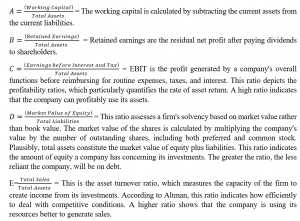Altman’s Z-Score model is a matrix statistic that predicts the likelihood of a company declaring bankruptcy during the next two years. It can be regarded as an indicator of a company’s financial stability by examining the corporate income and multiple balance sheet values.
Altman Z-score formula
The Altman Z score formula focuses on five crucial financial ratios. The Altman Z-score formula is;
ζ=1.2A+1.4B+3.3C+0.6D+1.0E

How to Calculate Altman Z score
The Altman Z-score, a statistical version of the classic z-score, is based on five financial measures that may be derived using data from a company’s annual 10-K report. Altman Z-Score is calculated as follows:
ζ=1.2A+1.4B+3.3C+0.6D+1.0E

How to interpret Altman Z score
The smaller the Z-score, the greater the likelihood that a corporation will go bankrupt. A Z-score less than 1.8 implies that the firm is in financial difficulties and is vulnerable to financial bankruptcy.
A score of 3 or higher, on the other hand, implies that the firm is in a secure zone and is unlikely to file bankruptcy. A score of 1.8 to 3 implies that the firm is in the grey region and has a substantial possibility of declaring bankruptcy.
Analysts use Altman’s Z-score to assess if to buy or sell an equity asset depending on its financial health. Investors can consider purchasing a company’s stock if its Z-score is close to 3, as there is a minimal chance that it will fail within the next two years. However, suppose a firm’s Z-score is near 1.8. In that case, shareholders may think about selling the company’s shares to prevent losing their holdings since the score implies a considerable risk of bankruptcy. Notably, the financial ratios in the z score also facilitate the investors to know where they can revise in case they buy the company.
The variable A in the Altman Z score formula is the working capital to total assets ratio. The size of its working capital determines a company’s short-term financial stability. A corporation can satisfy its short-term financial obligations and have money left over to develop and expand if its working capital is positive. Negative working capital, on the other hand, denotes a firm’s inability to satisfy its short-term financial commitments due to insufficient cash flows.
The variable B in the Altman Z score formula is the retained earnings to total assets ratio. A lower cash reserves to total assets ratio indicates that a corporation borrows money to pay for its expenses rather than using money from its retained earnings. It makes a firm’s chance of bankruptcy higher. A high ratio of retained earnings to total assets, on the other hand, indicates that a business uses its retained earnings to pay for capital expenditures. It demonstrates that the business has been profitable and is not dependent on borrowings.
The variable C in the Altman Z score formula is the earnings before interest and tax (EBIT) to total assets ratio. The EBIT/Total Assets ratio illustrates a company’s capacity for revenue generation necessary to maintain profitability, current finance operations, and repay loans.
The variable D in the Altman Z score formula indicates the market value of the equity to total liabilities ratio. The market value of equity/total liabilities ratio demonstrates how much a firm would lose in market value if it filed for bankruptcy before its obligations exceeded the value of its assets. Investor trust in the company’s financial stability can be perceived as high when the market value of the equity to total liabilities ratio is high.
The variable E in the Altman Z score formula depicts the sales to total assets ratio. The sales-to-total-assets ratio demonstrates how well management generates revenue from assets compared to the industry competition. A high sales-to-total-assets ratio indicates that the management only needs to make a low investment to boost revenue, which raises the company’s overall profitability. A low or declining sales-to-total-assets ratio, on the other hand, indicates that the company will need to devote more resources to produce adequate sales, which will lower the firm’s profitability.
Z double prime score
Z double prime score is specifically used for non-manufacturing firms. It is also a model developed by Edward Altman to facilitate identifying non-manufacturing that may fall into bankruptcy. According to Altman, a company with a Z score of less than 1.1 is in a “distress zone” and consequently has a greater chance of bankruptcy than its rivals.
Z score credit rating
Z-score credit rating is an outcome of a credit-strength analysis that assists in determining the possibility of bankruptcy for a publicly listed company.
What is a good Altman Z score?
A good Altman Z score ranges from 3 to 4, considered a safe zone. This indicates that the company’s financial situation is satisfactory. It is financially sound. This is a great firm to consider if one is looking to invest. A score between 2.9 and 1.8 is regarded as “gray.” Companies with a score in this scope are not very secure. Their finances are not stable, and if things improve, they may enter the “danger zone.”
Advantages and Disadvantages of Altman Z score
The advantage of the Altman Z score is that it is a great model that can realistically simulate a strategic course. Corrective actions can be taken if the alarm is raised in time.
Notably, there are various Altman Z-score limitations. This includes;
- Altman’s first model is inappropriate for small, non-manufacturing, or private businesses. Altman’s model is built using statistical data from publicly traded manufacturing companies. He also exempted all enterprises with investments of less than $1 million.
- The Altman Z score cannot be used with financial companies since the data may not be readily available.
- The Altman Z score is only as accurate as the data used. If a company gives inaccurate data used in the computation, the value will be biased in determining the possibility of bankruptcy.
